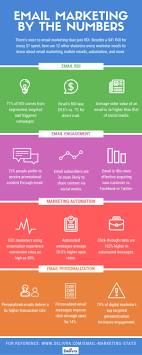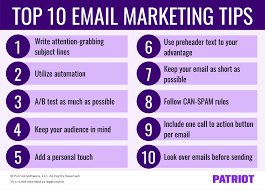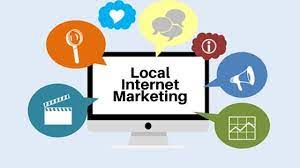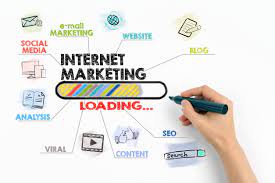Digital Marketing Email Campaigns: Unlocking the Power of Personalized Communication
In today’s fast-paced digital world, businesses are constantly seeking innovative ways to connect with their target audience. One such method that has proven to be highly effective is digital marketing email campaigns. With the ability to reach a wide audience instantly and deliver personalized messages, email campaigns have become an indispensable tool for businesses of all sizes.
Personalization is Key
Gone are the days of generic mass emails flooding inboxes. Today, successful email campaigns rely on personalization to capture the attention of recipients. By tailoring messages to individual preferences, demographics, and past interactions, businesses can create a sense of relevance and build stronger connections with their audience.
Segmentation: The Power of Precision
Segmentation is at the heart of successful email campaigns. By dividing your subscriber list into specific segments based on factors such as age, location, interests, or purchase history, you can send targeted messages that resonate with each group. This approach ensures that your emails are more likely to be opened, read, and acted upon.
Engaging Content: Informative and Compelling
To stand out in a crowded inbox, your email content must be engaging and compelling. Whether you’re promoting a new product or offering valuable insights through newsletters or blog updates, make sure your content is informative and adds value to your subscribers’ lives. Consider incorporating eye-catching visuals, concise yet impactful copywriting, and clear calls-to-action (CTAs) that encourage recipients to take the desired action.
Automation: Efficiency at its Finest
Automation has revolutionized digital marketing email campaigns by allowing businesses to streamline their communication efforts while maintaining a personal touch. With automation tools, you can set up triggered emails based on specific actions or events (e.g., welcome emails for new subscribers or abandoned cart reminders). This not only saves time but also ensures timely follow-ups and enhances customer experience.
Testing and Analysis: Constantly Evolving
Digital marketing email campaigns are not a one-size-fits-all solution. To maximize their effectiveness, it’s crucial to test different elements such as subject lines, CTAs, layouts, and send times. By analyzing the results of these tests, you can gain valuable insights into what resonates best with your audience and continually refine your email campaigns for optimal performance.
Compliance: Building Trust and Respecting Privacy
In an era of heightened privacy concerns, it’s essential to prioritize compliance with data protection regulations such as the General Data Protection Regulation (GDPR). Obtaining explicit consent from subscribers, providing clear opt-out options, and safeguarding personal information are vital for building trust and maintaining a positive reputation.
Conclusion
Digital marketing email campaigns offer businesses a powerful tool to engage with their audience on a personal level. By leveraging personalization, segmentation, engaging content, automation, testing, and compliance, businesses can unlock the full potential of email marketing. Embrace this dynamic approach to reach your target audience effectively and drive meaningful results for your business in today’s digital landscape.
5 Essential Tips for Effective Digital Marketing Email Campaigns
- Craft a compelling subject line
- Personalise your emails
- Optimise for mobile devices
- Test and measure results
- Follow email best practices
Craft a compelling subject line
Craft a Compelling Subject Line: The Gateway to Successful Email Campaigns
In the world of digital marketing email campaigns, the subject line holds immense power. It is the first impression, the deciding factor that determines whether your email will be opened or sent straight to the dreaded “spam” folder. Crafting a compelling subject line is therefore crucial for capturing your audience’s attention and increasing your email open rates.
The key to a successful subject line lies in its ability to intrigue and entice recipients. It should be concise, engaging, and relevant to the content of your email. Here are some tips to help you craft an irresistible subject line that stands out in a crowded inbox:
- Be Clear and Concise: Keep your subject line short and to the point. Aim for around 40-60 characters to ensure it is fully visible on mobile devices and doesn’t get cut off.
- Create Urgency: Incorporate words that evoke a sense of urgency or exclusivity. Phrases like “Limited Time Offer” or “Last Chance” can compel recipients to open your email promptly.
- Personalization: Use personalization tokens to address recipients by their name or include other personalized elements based on their preferences or past interactions. This adds a touch of familiarity and makes the email feel more tailored to their needs.
- Ask Questions: Pose intriguing questions that pique curiosity and make recipients curious about finding the answers within your email content.
- Use Power Words: Incorporate powerful words that evoke emotion, such as “Discover,” “Exclusive,” “Unlock,” or “Revolutionary.” These words create excitement and make your email stand out from the rest.
- A/B Testing: Experiment with different subject lines by conducting A/B tests with small segments of your subscriber list. Analyze open rates and click-through rates to determine which subject lines resonate best with your audience.
- Avoid Spam Triggers: Steer clear of using all caps, excessive punctuation, or words that commonly trigger spam filters. These can negatively impact your deliverability and reduce the chances of your email reaching the recipient’s inbox.
Remember, the subject line is your gateway to a successful email campaign. It’s the invitation that entices recipients to open and engage with your content. By crafting a compelling subject line that grabs attention and sparks curiosity, you can significantly improve your email open rates and set the stage for a successful digital marketing campaign.
Personalise your emails
Personalise Your Emails: The Key to Connecting with Your Audience
When it comes to digital marketing email campaigns, personalisation is a game-changer. Gone are the days of sending generic, one-size-fits-all messages that end up lost in crowded inboxes. Today, the key to connecting with your audience lies in personalising your emails.
Why is personalisation so important? Well, think about it – we all receive countless emails every day. Most of them go unnoticed or get deleted without a second thought. But when we see an email that speaks directly to us, addressing our needs and interests, it grabs our attention.
By personalising your emails, you create a sense of relevance and show your audience that you understand them as individuals. This not only increases the chances of your emails being opened but also encourages recipients to engage with your content and take action.
So how can you effectively personalise your emails? Here are a few tips:
- Use Recipient’s Name: Start by addressing each recipient by their name. It may seem simple, but it adds a personal touch and makes the email feel like it was crafted specifically for them.
- Segment Your Audience: Divide your subscriber list into segments based on demographics, interests, or past interactions. This allows you to send targeted messages that resonate with each group, increasing the likelihood of engagement.
- Tailor Content: Craft content that aligns with each segment’s preferences and needs. Whether it’s product recommendations based on past purchases or tailored offers for specific demographics, customising the content shows that you value their individuality.
- Triggered Emails: Set up automated triggered emails based on specific actions or events. For example, send a welcome email series to new subscribers or follow-up emails after a purchase. These timely and relevant messages enhance customer experience and nurture relationships.
- Personalised Recommendations: Leverage data insights to provide personalised recommendations or suggestions based on the recipient’s browsing or purchase history. This demonstrates that you understand their preferences and can offer tailored solutions.
Remember, personalisation goes beyond simply inserting a name into an email. It’s about understanding your audience, anticipating their needs, and delivering content that resonates with them on a personal level.
By personalising your emails, you can cut through the noise and stand out in crowded inboxes. Take the time to understand your audience, segment your lists, and craft tailored content that speaks directly to each recipient. The result? Stronger connections, higher engagement rates, and ultimately, better results for your digital marketing email campaigns.
Optimise for mobile devices
Optimise for Mobile Devices: Ensuring Your Email Campaigns Reach Every Screen
In the age of smartphones and tablets, it’s crucial to optimise your digital marketing email campaigns for mobile devices. With a significant portion of email opens happening on mobile, failing to cater to this audience can result in missed opportunities and decreased engagement. Here’s why optimising for mobile devices is essential and how you can do it effectively.
Mobile-First Mindset
When crafting your email campaigns, adopting a mobile-first mindset is key. Consider that recipients will be viewing your emails on smaller screens with limited attention spans. Keep your content concise, visually appealing, and easy to navigate. Avoid large blocks of text and ensure that images are appropriately sized for mobile screens.
Responsive Design
Responsive design ensures that your emails adapt seamlessly to different screen sizes and orientations. Utilising responsive email templates allows your content to adjust dynamically, providing an optimal viewing experience across all devices. This approach eliminates the need for recipients to zoom in or scroll excessively, making it more likely that they’ll engage with your message.
Clear Call-to-Action (CTA) Buttons
On mobile devices, it’s crucial to make your CTAs prominent and easy to tap. Use large buttons with clear labels that stand out from the rest of the content. Ensure there is enough space around them so that users don’t accidentally tap the wrong element. By simplifying the action process, you increase the likelihood of recipients taking the desired action.
Short Subject Lines
Mobile screens typically display fewer characters in subject lines compared to desktops. Craft concise subject lines that capture attention within limited space. Make sure they convey the value or purpose of your email effectively while remaining engaging and compelling.
Optimised Loading Speed
Mobile users expect fast-loading web pages and emails. Optimise your email campaigns by reducing file sizes, compressing images without compromising quality, and avoiding excessive use of animations or heavy media. By improving loading times, you enhance the user experience and prevent recipients from abandoning your email due to slow loading.
Testing and Previewing
Before sending out your email campaigns, test them thoroughly on various mobile devices and email clients. This ensures that your emails appear as intended across different platforms, avoiding any formatting or rendering issues. Many email marketing platforms offer previewing options specifically for mobile devices, allowing you to fine-tune the appearance before hitting send.
Conclusion
Optimising your digital marketing email campaigns for mobile devices is no longer optional; it’s a necessity. With a growing number of users accessing emails on their smartphones and tablets, catering to this audience is crucial for success. By adopting a mobile-first mindset, embracing responsive design, using clear CTAs, crafting short subject lines, optimising loading speed, and testing thoroughly, you can ensure that your emails reach every screen seamlessly. Don’t miss out on engaging with your mobile audience – make mobile optimisation a priority in your email marketing strategy.
Test and measure results
Testing and Measuring Results: The Key to Optimizing Digital Marketing Email Campaigns
In the ever-evolving world of digital marketing, staying ahead of the competition requires constant adaptation and improvement. When it comes to email campaigns, testing and measuring results play a crucial role in optimizing your strategies for maximum impact.
Testing different elements within your email campaigns allows you to gather valuable insights into what resonates best with your audience. By experimenting with variables such as subject lines, CTAs, visuals, layouts, or even send times, you can uncover which elements drive higher open rates, click-through rates, and conversions.
One effective testing method is A/B testing or split testing. This involves creating two or more versions of an email campaign and sending them to different segments of your subscriber list. By comparing the performance metrics of each variant, you can identify which version performs better and learn from it.
Subject lines are often the first point of contact with your audience. Testing different subject lines can help you determine which ones are more likely to capture attention and encourage recipients to open your emails. Consider experimenting with different tones (e.g., informative vs. playful), lengths, personalization techniques, or even posing questions to pique curiosity.
CTAs are another critical element that can significantly impact conversion rates. Test variations in wording, design styles (e.g., buttons vs. hyperlinks), placement within the email body, or even color schemes to see which combinations generate higher click-through rates.
Layouts and visuals also play a role in capturing attention and conveying your message effectively. Test different templates or designs to find out what resonates best with your audience’s preferences. Additionally, consider experimenting with the use of images versus text-only emails or incorporating videos or GIFs for added engagement.
Timing is everything when it comes to sending emails. Test different send times and days of the week to identify when your audience is most receptive. Keep in mind that optimal timing may vary depending on your target audience, industry, and geographic location. By analyzing open rates and engagement metrics across different send times, you can refine your scheduling for better results.
Measuring the results of your tests is equally important. Track key performance indicators such as open rates, click-through rates, conversion rates, and unsubscribe rates to gauge the effectiveness of your email campaigns. Use analytics tools to gain insights into subscriber behavior and identify patterns or trends that can inform future strategies.
Remember that testing and measuring should be an ongoing process. As consumer preferences and behaviors evolve, so should your email campaigns. Continually test new ideas and adapt based on the results you gather.
In conclusion, testing and measuring results are essential steps in optimizing digital marketing email campaigns. By experimenting with different elements, analyzing performance metrics, and making data-driven decisions, you can refine your strategies to achieve higher engagement rates, conversions, and ultimately drive meaningful results for your business. Embrace the power of testing to stay ahead in the ever-changing digital landscape.
Follow email best practices
Follow Email Best Practices: Enhancing the Success of Your Digital Marketing Campaigns
In the realm of digital marketing, email campaigns play a vital role in connecting businesses with their target audience. To ensure the success of these campaigns, it is crucial to follow email best practices. By adhering to these guidelines, you can enhance the effectiveness of your emails and achieve better engagement and conversion rates.
First and foremost, maintaining a clean and well-maintained email list is essential. Regularly review your subscriber list to remove inactive or unengaged contacts. This will not only improve your deliverability rates but also help you focus your efforts on those who are genuinely interested in your content or offerings.
Crafting compelling subject lines is another crucial aspect of email best practices. Your subject line acts as the first impression for recipients, so make it attention-grabbing and concise. Avoid using spammy or misleading language that may cause your emails to end up in the dreaded spam folder.
When it comes to email content, keep it concise, relevant, and visually appealing. Busy recipients often skim through their emails, so make sure your message is easy to digest at a glance. Use clear headings, bullet points, and visuals to break up text and make it more engaging.
Personalization is key in today’s digital landscape. Tailor your emails based on recipient preferences or past interactions with your brand. Address recipients by their name whenever possible and segment your audience to deliver more targeted messages that resonate with their specific needs or interests.
Timing matters when it comes to sending emails. Pay attention to open rates and engagement metrics to determine the optimal send times for different segments of your audience. Experiment with different days and times until you find what works best for maximum impact.
Mobile optimization cannot be overlooked in this smartphone-dominated era. Ensure that your emails are mobile-friendly with responsive designs that adapt seamlessly across various devices and screen sizes. A poor mobile experience can lead to high unsubscribe rates and missed opportunities.
Finally, always provide a clear and prominent call-to-action (CTA) in your emails. Whether it’s directing recipients to make a purchase, sign up for a webinar, or download an e-book, make the CTA stand out and guide them towards the desired action.
By following email best practices, you can enhance the success of your digital marketing campaigns. From maintaining a clean email list to crafting compelling content, personalizing messages, optimizing for mobile, and including strong CTAs, each step contributes to better engagement and ultimately drives the desired results for your business. Embrace these best practices and watch your email campaigns thrive in today’s competitive digital landscape.




